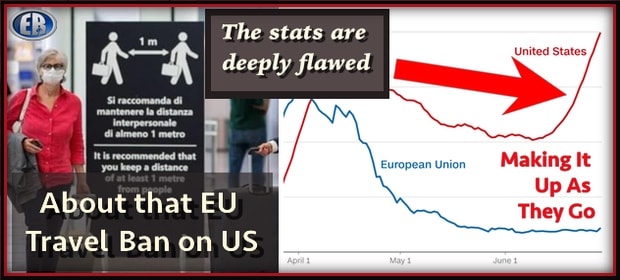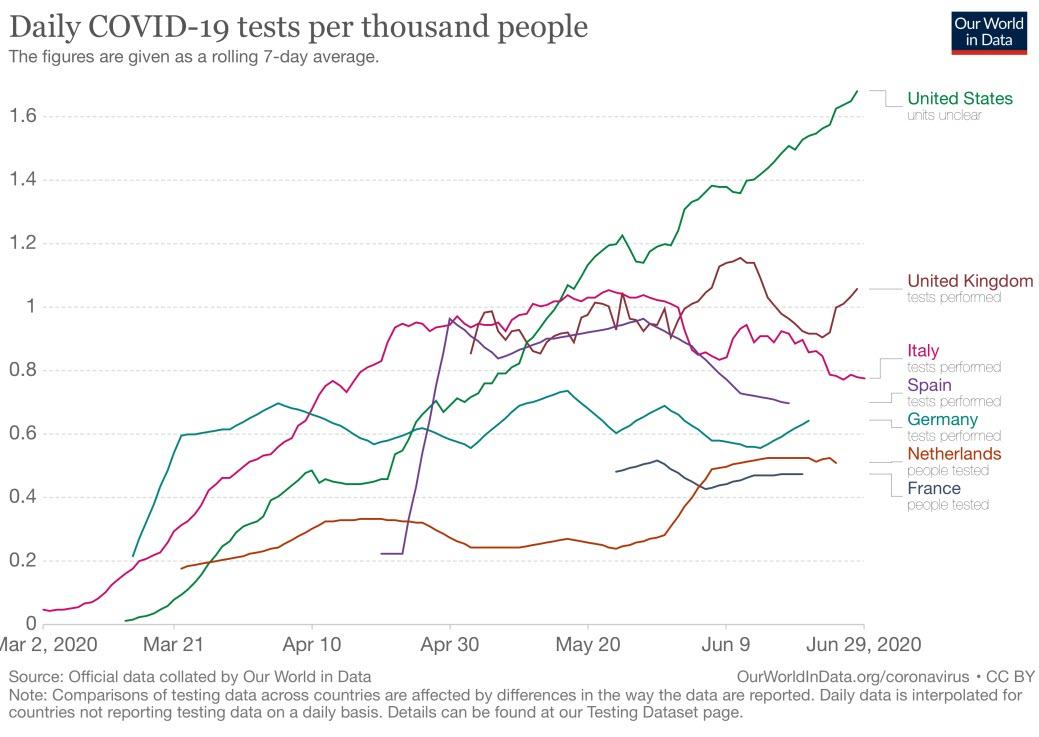
EU Ban On US Travelers Relies On Misleading COVID Data, Punishes Testing Gains
With the number of reported coronavirus infections rising in the U.S., the European Union on Tuesday adopted recommendations extending travel restrictions that effectively ban non-essential American business and leisure travelers.
The ban would remain in effect until the U.S. infection rate falls to a level comparable to or lower than the European rate and the number of new cases nationwide starts trending downward.
Although the guidance approved by the European Council is non-binding on EU member states, the economic repercussions of the action could be severe on both sides of the Atlantic.
Prior to the pandemic, Europe was earning fully 10% of its revenue from tourism, with much of that from the U.S. Further, a new IMF report concludes it’s the advanced nations of the world that will take the biggest hit from coronavirus fallout, so there are powerful economic incentives for the EU and the U.S. to mutually relax travel restrictions.
While Europe’s ban on travel from countries with high infection rates appears sound on the surface, the data underlying its exclusion of U.S. travelers is misleading to the point of being false.
At a glance, the rate of U.S. infections (or “cases,” whether or not infections result in COVID-19 symptoms) is vastly higher than that of any European country except tiny ones like the Vatican City and Andorra. And who wants visitors from a plague hotbed?
And yet, the U.S. infection “case rate” obscures something crucially important that is being missed — or ignored — by the media on both sides of the pond: Despite the high U.S. rate, six major European countries have a higher per-capita death rate than the U.S., and a couple of others are on about the same level. (Maybe U.S. healthcare for COVID-19 patients is better, but that much better?)
What really explains the higher U.S. infection is twofold.
First, U.S. testing per capita has soared far above that of the major European countries. As with any other disease, whether infectious or not — heart disease, cancer, etc. — the more you test, the more you find. So, in banning travel from the U.S. while ignoring the causal link between increased testing and increased infections rates, the EU is in effect punishing the rapid expansion of testing in the U.S.
Second, as The Atlantic reported last month in article entitled “How Could the CDC Make That Mistake?,” theU.S. Centers for Disease Control and Prevention (CDC), under its controversial director Robert Redfield, is conflating antibody tests that indicate past infection with antigen (viral) tests showing current infection. That superficially scary U.S. infection rate thus includes antibody-positives, who actually make the most desirable foreign visitors because they won’t get sick on your soil and won’t be infecting your people. The commingling of the two kinds of tests, moreover, is made to order for double-counting, since a person who tests positive for the actual virus will later probably test positive for the antibody also.
So those articles you’ve been reading about U.S. case rates going back up (while deaths suspiciously stay flat or decline)? The best explanation may not be the easing of lockdown restrictions, as has been implied by innumerable scare headlines in the media. It may instead be the U.S. testing surge, plus case numbers misleadingly inflated by double-counting.
“You’ve got to be kidding me,” Ashish Jha, the K. T. Li Professor of Global Health at Harvard and the director of the Harvard Global Health Institute, said to The Atlantic when told what the CDC was doing.
“This is a mess,” he said.
Whether it’s somehow a “mistake” as both he and article state is debatable, but either way, the U.S. government has effectively invited exaggerated COVID-19 numbers in multiple ways, including:
- The CDC does not require COVID-19 positivity to declare a case as coronavirus
- The CDC has conflated “death with” the virus and “death from” to the extent that the number of fatalities attributed to COVID-19 may be highly inflated.
- The Medicare program that covers Americans over age 65 pays a 20% premium if a case is declared COVID-19, which creates a strong temptation for hospitals to overcount.
If it’s hard to conceive why European governments would forfeit badly needed American tourist dollars simply because of surging U.S. testing combined with a counting methodology that overstates case numbers,perhaps it’s because the EU has an additional, unacknowledged motive beyond public health, namely retaliation: Remember, President Trump blocked travel to the U.S. from all 26 member nations of the European Schengen Area in mid-March, before Europe blocked the U.S.
The U.S. stands to take a big economic hit of its own by keeping its doors closed to Europeans. In March, Tourism Economics estimated the U.S. travel and tourism industry could lose at least $24 billion in foreign spending this year because of COVID-19 travel restrictions.
With summer travel season in full swing and the worst of the pandemic now behind both Europe and the U.S., time is running out for both sides to open their doors and start helping each other back to economic health.
************
Original article

••••
The Liberty Beacon Project is now expanding at a near exponential rate, and for this we are grateful and excited! But we must also be practical. For 7 years we have not asked for any donations, and have built this project with our own funds as we grew. We are now experiencing ever increasing growing pains due to the large number of websites and projects we represent. So we have just installed donation buttons on our websites and ask that you consider this when you visit them. Nothing is too small. We thank you for all your support and your considerations … (TLB)
••••
Comment Policy: As a privately owned web site, we reserve the right to remove comments that contain spam, advertising, vulgarity, threats of violence, racism, or personal/abusive attacks on other users. This also applies to trolling, the use of more than one alias, or just intentional mischief. Enforcement of this policy is at the discretion of this websites administrators. Repeat offenders may be blocked or permanently banned without prior warning.
••••
Disclaimer: TLB websites contain copyrighted material the use of which has not always been specifically authorized by the copyright owner. We are making such material available to our readers under the provisions of “fair use” in an effort to advance a better understanding of political, health, economic and social issues. The material on this site is distributed without profit to those who have expressed a prior interest in receiving it for research and educational purposes. If you wish to use copyrighted material for purposes other than “fair use” you must request permission from the copyright owner.
••••
Disclaimer: The information and opinions shared are for informational purposes only including, but not limited to, text, graphics, images and other material are not intended as medical advice or instruction. Nothing mentioned is intended to be a substitute for professional medical advice, diagnosis or treatment.





